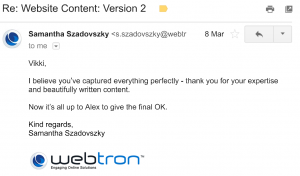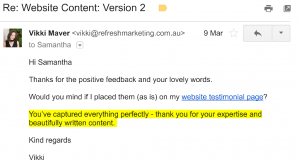
27 Oct Customer Testimonials: Is your business screwing it up?
Whether you’re an Uber driver or eBay seller, a copywriter or consultant, establishing credibility is critical to your marketing success. Purchasers want evidence to show that you or your business can be trusted.
And one of the best ways to prove your credibility is to offer your prospects real endorsements from real people. Otherwise known as client or customer testimonials.
Okay, none of what I’ve just told you may be news to you. And you may think you’ve ticked testimonials off your marketing to-do list. But very few businesses get it right when it comes to gathering, producing and publishing testimonials.
So before you close the browser window, take a quick scan of these 11 hacks for testimonial success.
1. Make it habit
If you don’t already have testimonials from satisfied customers, it’s never too late to start collecting them. But it will be painstaking – especially if it means having to track down customers you serviced several months (or even years) ago.
You’re much better off asking for endorsements as soon as you’ve made a sale or completed a project. Why? Because you’re top of mind. And because your customer will still be feeling warm and fuzzy about their purchase or experience.
Asking for testimonials soon after the transaction should be part of your routine. Just like sending the invoice.
Don’t think of testimonial gathering as an annual task. Think of it as an ongoing commitment to your marketing. It’s not about reaching a magic number and then stopping either. Keep collecting as long as you’re in business.
2. Only three testimonials? Don’t bother.
If you’re going to the effort of creating a testimonials page on your website, ensure you have enough to make it worthwhile.
A list of just three or four testimonials tells your prospects you don’t really have that many satisfied customers.
You see, often, it’s the sheer volume of testimonials – rather than the words themselves – that we find most convincing. Ideally, you want one testimonial after another, spilling over five or six scrolling pages.
Prospects don’t even have to read them to see that you’re making a lot of people happy!
3. Make it as easy as possible for your customer to provide them
Even when customers are over the moon with your products or services, many people procrastinate when asked to write testimonials. It’s simply not a priority in their busy day.
So make it quick and easy for them. And that means being as specific as possible when stating what you’re after.
So instead of:
Hey, can you please write us a testimonial?
Try:
Can you please email me 2-3 simple sentences about how satisfied you are with your new ab-cruncher?
Even better if you can prompt them with specific questions such as:
Why did you decide to buy our brand of ab-cruncher?
What three words would you use to describe your new ab-cruncher?
What makes our ab-cruncher different or better than others you have tried?
And finally, request bullet points only. You can always morph their sentiments into something more readable and structured later.
4. Make them easy to read and scan
Wow! Your newest customer has just written you a glowing 552-word reference – and you’re blown away. Which of course, is understandable.
But before you paste it onto your website verbatim, ask yourself: is anyone going to be as invested as me in reading every last word of this?
Of course not.
If you really want it to be read, cut it down to a short and succinct statement. (Chances are, that 552 paragraph is repetitive and full of waffle anyway.) Ideally, your testimonials should be around 30-50 words – but definitely no more than 80.
Another effective technique for easier scanning and higher engagement is to add headings to each of your testimonials. Simply pull out the most compelling statement or line in the testimonial and you have your heading!
5. Edit them. Properly.
Okay, so we’ve already established that we need to keep testimonials short and succinct.
But you also want them to be well written and grammatically correct.
Even though your testimonials were technically written by a third party, poor writing anywhere on your website (or other marketing materials) makes your business look sloppy and amateurish.
So take the time to edit every testimonial you receive. Or if writing’s not your strong suit, engage a professional copywriter to do it on your behalf.
(If a testimonial needs significant editing, it’s a good idea to ask the customer for final review and sign-off before publishing.)
6. Position them on your website… smartly
Where do your testimonials appear on your website?
Sorry to break it you, but not many people go out of their way to look for testimonials. So don’t bury them within your website menu structure, expecting your customers to search for them.
Instead, place them strategically on key pages so that your prospects will have no choice but to notice them while researching your business.
You can feature testimonials on your homepage, header, footer or sidebar. Whatever works for you.
7. Milk ’em… and milk ’em hard
So you’ve gathered countless client testimonials over many years and they look fabulous on your website. But where else are you using them?
Are you getting maximum value from these brilliant pieces of social proof?
Here’s where else you should be using them:
- Flyers and brochures
- Print advertisements
- Sales proposals
- At the bottom of your sales-focused emails
- Your LinkedIn profile (as ‘Recommendations’)
8. Capture incidental endorsements
Have you ever received an email or phone call from a client who sang your praises without being prompted?
Great client testimonials don’t have to be initiated by you. When customers are happy, they often sometimes tell us so. The important thing is to recognise these priceless moments when they happen – and to convert passing comments into official endorsements.
Who knows. You might be lucky to be sent an email that barely needs editing. Like this one I received earlier this year:
And boy, did I jump on that baby quick smart. Here was my reply:
9. Ensure statements are specific. And varied
Do your testimonials convey the breadth of your competitive strengths?
Testimonials that are repetitive or rely on vague phrases such as ‘great service’ or ‘would recommend to others’ lack conviction. Try and elicit more specific statements from your customers that detail exactly what was so great about your service.
Was it your efficiency, your attentiveness or your helpful, consultative approach?
Chances are, there are many good reasons for choosing your business. So use your testimonials as a platform to showcase them all.
10. Specify the source. Always.
If your customer is not prepared for you to attach their name to their statement, the testimonial is immediately less valuable. And less credible.
The more you can do to prove the legitimacy of your customers’ words, the more convinced your prospects will be. And that means as much information about the source as you can provide – first name, surname, job title, business name, shoe size – the works!
That’s also why B2B testimonials are far more compelling than B2C.
Which of these is more convincing to you?
Mary Harquin
Managing Director
ESSEX Enterprises
Or
Susie from Langwarrin
11. Consider video testimonials
(Disclaimer: I am yet to get video testimonials for my own business, but I know it’d be bloody brilliant if I did.)
Creating video testimonials definitely takes more effort and planning – but they’re a lot more engaging. Many people also perceive them to be more legitimate and credible than written testimonials.
Your videos don’t have to be professionally produced (your iPhone will probably do the trick). But many of the same rules I’ve talk about in this post still apply, such as:
- Keep them short and succinct
- Position them strategically on your website
- Ensure they’re specific and varied
Now it’s over to you. Which hacks are you going to implement to boost the power of your client testimonials?



